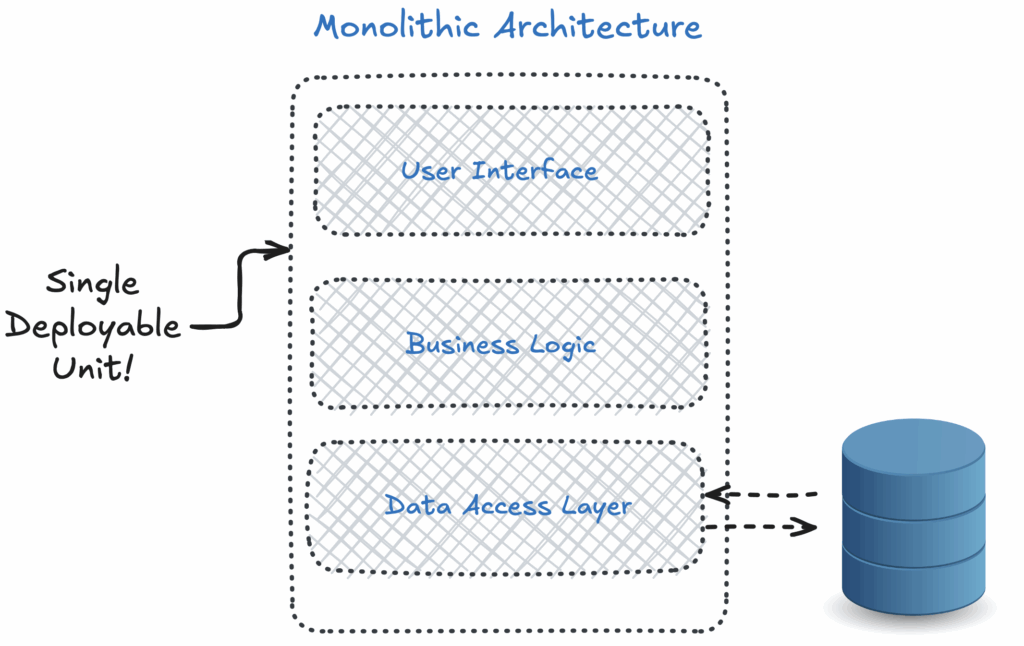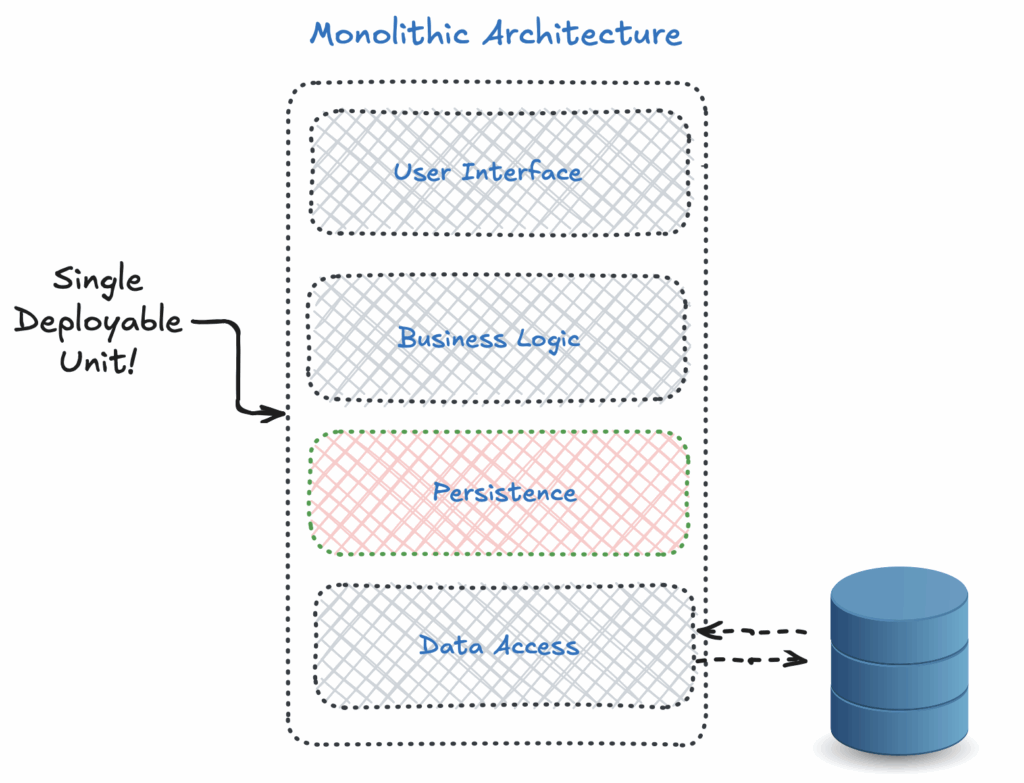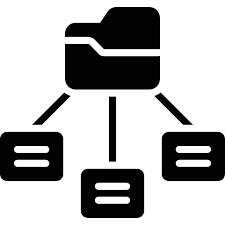Software Architecture Patterns (Part 1) – Monolithic Architecture
Software Architecture is essentially the big-picture structure of a software ecosystem. It outlines how the system is organized and how its parts are put together and how they work with one another by a well-defined communication style(s). Think of it as a blueprint that shapes the system’s design and guides decisions around development and maintenance.
In this article series, we’ll explore some of the most popular Software Architectural Patterns, examining their advantages and disadvantages. In this first part, we’ll take a closer look at the Monolithic Architecture pattern.

Definition
Monolithic Architecture is a software design pattern where the entire application is built, packaged, and deployed as one unified system. All features live in the same code-base and run together as a single process.
That said, a monolithic application can still be well-organized internally. Developers often use patterns like layered architecture, modular monoliths, or Domain Driven Design to keep architecture clean and maintainable.

What defines a software architecture as Monolithic Architecture isn’t how it’s structured on the inside, but the fact that it’s deployed as a single, tightly coupled unit.
This is an important distinction, especially when comparing monoliths to other architectural style like modular monoliths, where individual parts of the system can be deployed and scaled independently.

Architecture & Anatomy
In monolithic architecture, the entire application is created and deployed as a single unit. Though the application is organized into multiple layers, presentation, business logic and data access. These are part of the same code-base and run in the same environment.
When we speak about it being one deployment unit, we mean all the layers share the same memory space, make intrinsic function calls, and are likely to be developed on a shared technology base. Because of this tight integration, something we’ll address in the later pros an& cons section, communication among modules typically happens in-process and synchronously. This allows for high-speed interactions but complicates other genuine modularity.
👉 Presentation Layer
The Presentation Layer is tasked with handling all user interactions with the system, such as presenting information and reading user inputs. It consists of presentation elements like web pages, APIs, mobile interfaces, or desktop GUIs that act as the point of entry to the application. This layer interprets user actions as requests for the underlying business logic and presents the system’s responses in a form suitable for the user.

👉 Business Logic Layer
This layer holds the chief rules, policies, and decision-making processes that dictate application behavior. It converts presentation layer input, enforces domain logic, checks data for validity, and manages workflows among entities. This layer causes the system to behave in a deterministic way based on business requirements independent of data presentation or storage.
👉 Data Access Layer
The Data Access Layer manages all communication between the application and data storage systems, such as databases, file systems, or third-party APIs. It holds the data access logic for querying, inserting, updating, and deleting data, offering consistent and secure access to persistent storage. By abstracting direct database interaction, this layer facilitates separation of concerns and allows business logic to remain focused on application rules rather than data handling details.
There is developed model for monolithic architecture that adds a new layer in between the Business Logic and Data Access layers, Persistence Layer.

👉 Persistence Layer
This layer acts as mediator which does object-relational mapping, repositories, and entity lifecycle management. Moreover, Adding a Persistence Layer between the Business Logic and Data Access layers, the architecture has an additional abstraction that keeps domain logic clean from database-specific code. Instead of the business logic being concerned with the database or running SQL queries, it’s concerned with the persistence layer in terms of concepts like entities or aggregates.
This extra layer makes the system testable, flexible, and maintainable in a sustainable way. It also promotes a cleaner domain model by decoupling infrastructure concerns from business rules so that teams can develop systems that are easier to understand, test, and evolve.

Use Cases
Monolithic Architecture, one of the most widely used and oldest architectural styles in the market, is implemented in a wide variety of industries. In this section, we explore three common use cases.
🛠️ Early-Stage SaaS Products & Startups
In fast-paced startup environments, the top priority is often on getting a product to market as quickly as possible. Monolithic Architecture allows for this with the capability to prototype and deploy rapidly with minimal operational complexity.

Frameworks like Spring or Laravel enable developers to simply build and deploy complete working applications from a single codebase, without having to concern themselves with the drawbacks of distributed systems. This is especially convenient when speed and team productivity matter more than long-term scalability.
🛠️ Established Enterprises
Most established companies (Banking, Insurance, …) still run monolithic applications built over decades. Sometimes they process mission-critical operations such as transaction processing, patient information, or claims handling. While not perhaps a delight to deal with, their monolithic structure was well-suited to the centralized IT and stability requirements of their time.
🛠️ Internal Business Tools
Monolithic Architecture is optimal for internal business applications that are accessed within an encapsulated organizational setup. Such applications typically address certain departments such as HR, finance, operations, or logistics and do not require scalability, modularity, or worldwide availability needed for public products.
Examples of the kind of systems include HR systems, inventory management systems employed in tracking quantities of stock, CRM (Customer Relationship Management) software intended for internal support or sales teams.

Pros & Cons
Monolithic Architecture clearly has advantages at the initial phases of development but comes with massive trade-offs with increasingly large and intricate applications. Let us take a look at some advantages and some disadvantages.

- It’s all in one code-base, so writing, testing, and debugging are easier, especially for tiny teams.
- Furthermore it is easy to deploy. One deployment unit means fewer moving pieces. On the other words, just package the app and deploy it.
- In-process communication between layers is fast and avoids network latency, which means it is performance efficient in this phase.
- Because of having unified technology stack, teams can focus on one set of tools, frameworks, and languages, which simplifies on-boarding and collaboration.

- Scalability is the most effective disadvantage of Monolithic Architecture. We can’t scale components independently. On the other words, horizontal scaling is all or nothing.
- The code-base is fragile at scale. It means as it grows, one change in a section can unintentionally impact others, increasing regression risks.
- Furthermore, One small update requires rebuilding and redeploying the entire app, slowing down continuous delivery.
- Another disadvantage is Technology Lock-In, which makes it difficult to bring in new tech into one module without rewriting large parts of the system.

Transformation & Evolution Considerations
Whereas Monolithic Architecture is a neat solution for early development in an startup company, it then reaches a point where shifting business needs require greater scalability, modularity, or accelerated development. It reaches a stage at which teams begin planning a transformational journey; typically to architectures like microservices, EDA, or modular monoliths.
Because of mentioned features for monolithic applications, a successful transformation is begun with strategic decomposition both in code-base and data. This can include finding bounded contexts in the application and splitting them out as independently deployable services over some amount of time. The other solution to transform Monolithic Architecture, which is the best practice for most cases, is introducing Domain-Driven Design.
Transforming a monolithic application with an incremental change, in reality, is generally more feasible and less hazardous. What follows are three of the finest architectural patterns used to transition away from monoliths to more distributed or modular systems:
🍀 Strangler Fig Pattern1
This approach is named after the evolution of a strangler fig tree, where it involves gradually replacing parts of a monolithic application with new services or modules. Over time, the new system grows around the old system until a monolith can be sunset. In this way, teams can separate and replace high-priority or high-risk modules without impacting the entire system.
🍀 Backend for Frontend (BFF)2
When UI or client-side aspects of a Monolithic Architecture are being revamped, a BFF layer, which is a lightweight service that does client-specific logic and communicates with the business logic or core, is usually introduced. It separates presentation concerns from core logic and leaves some space for front-end modernization without rewriting the back-end. On the other words, it is pattern to decouple back-end transformation from front-end modernization in an evolutionary process.
🍀 Event Interception Pattern3
Event Interception Pattern allows us to transform Monolithic Architecture by catching up with currently running business processes within the application without altering its essential business logic. You insert interceptors in order to catch major events, and then route them off to external systems or services for processing or analysis.
As an example, instead of refactoring the entire order processing system in an e-commerce application, we might publish an OrderPlaced event from the monolith and have outside-in microservices subscribe to it.

Wrapping Up
Monolithic Architecture remains one of the most used and popular software design patterns, particularly in startup companies. In compiling the whole application into a homogeneous, unified code-base and deployable unit, it allows teams to deploy rapidly with reduced infrastructure overhead.
But when applications grow larger and more complex, monoliths’ tight coupling and single-deployment style become limiting. Changes in one area have unintended side effects elsewhere, and it’s harder to scale individual parts of the system.
There is no reason transformation has to be disruptive. Solutions like the Strangler Fig Pattern enable incremental, low-impact change. Others like Event Interception Pattern allow developers to introduce functionality without having to rewrite the core.
Regardless of whether you maintain a monolith or upgrade it, the secret is to design with change in mind, having clean boundaries and modularity considerations at the center of your architecture from day one.
